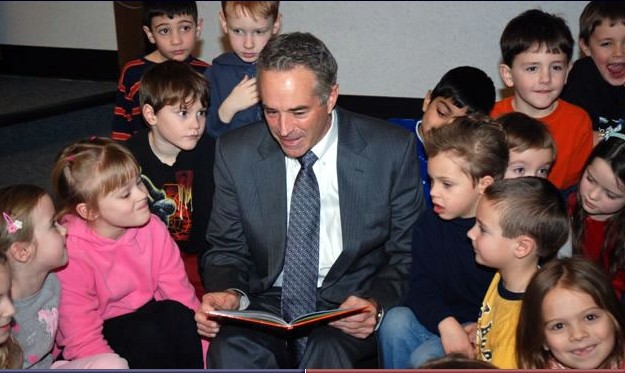Some Ideas for Making Rare Books Relevant from Buffalo, New York
- by Michael Stillman

Erie County Executive Chris Collins shares a book with some young readers (from the Executive website).
By Michael Stillman
For generations, rare book libraries have been obtaining and squirreling away enormous quantities of historic old books and ephemera. They have made them available to bona fide researchers but few others. However, researchers are themselves few in number, and as more material is made available through digital copies, need to access originals is diminishing. Few people ever view these great works, and out of sight is out of mind. So library hours get cut, budgets slashed, and no one knows whether these public collections can survive the new century. One community is determined to breathe new life into these old works, bring them back into the light of day where they once again can be appreciated by all. If they can pull this off, it could be a blueprint for communities all across the land as they try to answer the vexing question of what to do with these wonderful, but invisible artifacts of their history. It will not be easy.
Erie County (Buffalo), New York, is determined to make its antiquarian books and manuscripts a cultural draw, a tourist attraction if you will. Last month, County Executive Chris Collins announced the formation of a Rare Books Commission. It will draw its members from various local institutions. The commission will be headed by Victor Rice, a local philanthropist, and includes County Executive Collins, University at Buffalo President John Simpson, Erie Community College President Jack Quinn, Library Board Trustees Anne Leary and Wayne Wisbaum, Erie County Library Director Bridget Quinn-Carey, and Michele Lee, wife of Congressman Chris Lee. With a group of heavy hitters like this, one can only assume that Erie County is deadly serious about finding a way to convert their musty old books into living assets.
County Executive Collins describes their mission by explaining, "We have a wealth of incredibly rare treasures right here in Western New York that we should be sharing with the world. I think these historic materials will attract visitors from far and wide. It's time to market this collection to enhance our tourism industry in Erie County."
So what sort of treasures are there in this Great Lakes community, which despite the "New York" last name is closer to Cleveland, Detroit, Wheeling West Virginia, and Toronto than it is to the metropolis that goes by the name of "New York?" It turns out there are some surprises. Buffalo/Erie County houses the handwritten manuscript of Mark Twain's Huckleberry Finn. Twain lived here from 1869-71, owned his first home in Buffalo, and donated the manuscript for what many consider to be America's greatest novel to the local library. Thomas Jefferson's annotated copy of The Federalist, and a Shakespeare First Folio, the first printing of his plays, are also part of the Buffalo and Erie County Library Collection.
The Buffalo area is steeped in history. It was the starting point for the Erie Canal, which early in the 19th century single-handedly opened up what was then the American West for trade with the rest of the nation. Later, it was a major railroad hub. It was also a major terminus of a different type of railway, the Underground Railroad, where runaway slaves crossed the Niagara River for freedom in Canada. Presidents Grover Cleveland and Millard Fillmore came from Buffalo. President William McKinley died here, victim of an assassin's bullet while attending the 1901 Pan-American Exposition. The tragedy altered the course of American history by elevating an eccentric downstater, Theodore Roosevelt, to the presidency. Buffalo was the first city in the country with electric streetlights, earning it the nickname "City of Light." The area was also a major industrial powerhouse, once hosting the largest steel plant in the nation. And, of course, it is the gateway to Niagara Falls, and everyone must see the falls sometime in their life, meaning everyone should pass through Buffalo at least once.
S. Cooper Hawley, Director of Constituent Services in the County Executive's Office, informs us that while the committee is still in its infancy, it is beginning to explore various options, and the Administration is very hopeful they will be able to draw tourists to the county. "The Committee is currently working on generating higher visibility of the collection by bringing together institutions and collectors, whose holdings have not before been open to the public, into a cooperative framework. Our Administration hopes to establish a central location to showcase various parts of the collection. Several private foundations have been approached about possible funding for the project already."
This is really something of a counterintuitive idea for rare book libraries. So steeped in the desire to protect and preserve, they have made rare books virtually inaccessible, and thereby of no practical benefit to the public which pays for their preservation. The day may come when that public says no more. What the folks in Buffalo are trying to do is convert those resources into a practical asset, one that can pay for their own preservation and more, rather than be a draw on tight budgets. If they succeed, they may do as much to preserve the books and manuscripts of our history as all of the squirreling away in dark, climate-controlled vaults has accomplished. Ultimately, the public, which foots the bill, will demand a financial justification for all of this preservation. In Erie County, they seem to have recognized this point a little sooner than most. County Executive Collins and the other public-spirited citizens of Erie County who have taken on this challenge are to be congratulated for recognizing the hidden value in their libraries and collections. Buffalo may prove to be not only the "City of Light," but also the "City of Enlightenment."